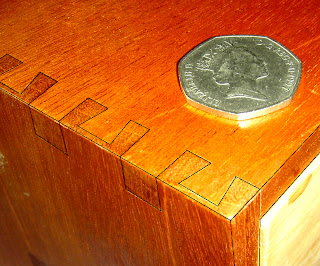In the world of woodworking there is nothing more striking than a dovetail joint and what it represents historically. Many still argue it is the strongest joint and when it come to cutting dovetails they have to be cut almost according to the gospel.
But I find it a little irksome when I see immaculate cabinetry at exhibitions and when I open the drawer I see the shoulder line left on. No, no, no. If you are going to stick to tradition stick to tradition! I also observe inconsistency as the shoulder line is never left on the carcase dovetail!
So who is the gospel according to? Well if we take the 50's and 60's as the zenith of handmade cabinetry, before machine woodworking got into gear, a Mr Charles Hayward was famous for a series of definitive books on practical woodworking and he was pretty well acknowledged as the authority. In fact nobody since has gone into the craft in anywhere near the depth of his books. He states clearly that the shoulder line should be removed and this teaching at the same time was coming out of the leading colleges Shoreditch and Loughborough. A light shoulder is first scribed and then deepened where the tail and pin portions are removed. the line there serves as a location for a chisel and saw.
Although many antiques display crude shoulder lines left on which on close inspection by the torn grain imply a marking gauge was used (rather than a try square and marking knife), it is no guide to proper practice or the best tradition. Many antiques were made by semi skilled craftsman and are so badly designed and made would be thrown out of an exhibition of contemporary furniture today.
Here endeth the lesson!
A carcase dovetail devised by Jeremy Broun combining a traditional lap dovetail and through dovetail.
This is a short extract from an article to appear in British Woodworking magazine soon

No comments:
Post a Comment